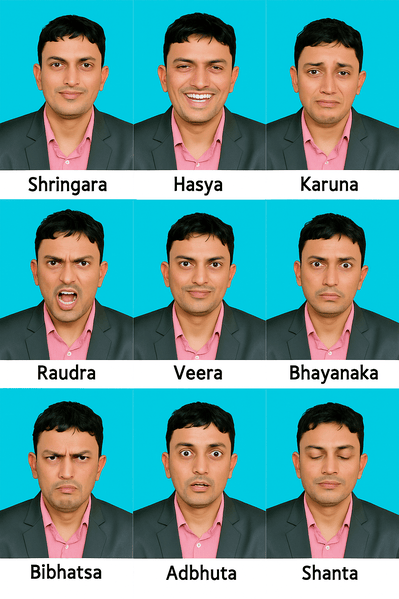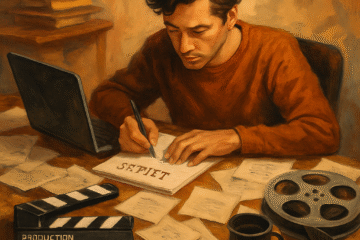Navarasa Emotions in Acting : Nine Emotions

In Indian classical performance traditions — from Bharatanatyam and Kathakali to Sanskrit drama — acting is built around the Navarasas, or “Nine Emotions.”
These are not just expressions, but complete emotional states that connect the performer with the audience, creating what the Natyashastra calls rasa — the essence or flavor of a performance.
For an actor, mastering the Navarasas is about understanding why a character feels something, how that emotion flows through the body, and what it communicates to the viewer.
1. Śṛṅgāra (शृंगार) – Love / Romance
- Essence: Attraction, beauty, devotion, tenderness.
- Mood: Joyous, gentle, often linked to love stories and relationships.
- Expression: Soft eyes, warm smile, graceful gestures.
- Actor’s Tip: Think about genuine admiration or affection you’ve felt; let your eyes “speak” more than your words.
2. Hāsya (हास्य) – Joy / Laughter
- Essence: Amusement, cheerfulness, playfulness.
- Mood: Light-hearted and infectious.
- Expression: Open smile, twinkling eyes, relaxed body.
- Actor’s Tip: Allow your laughter to be real — not forced — so it pulls the audience into the fun.
3. Karuṇā (करुणा) – Sorrow / Compassion
- Essence: Sadness, empathy, pity for suffering.
- Mood: Tenderness mixed with grief.
- Expression: Moist or heavy eyes, softened facial muscles, a lowered head.
- Actor’s Tip: Focus on the loss your character feels; the body will naturally slow down.
4. Raudra (रौद्र) – Anger
- Essence: Rage, intensity, justice-seeking.
- Mood: Explosive energy, powerful.
- Expression: Flared nostrils, wide eyes, tense jaw, aggressive gestures.
- Actor’s Tip: Use breath to fuel controlled power — don’t let it become uncontrolled yelling.
5. Vīra (वीर) – Heroism / Courage
- Essence: Confidence, strength, determination.
- Mood: Noble and inspiring.
- Expression: Upright posture, steady gaze, firm voice.
- Actor’s Tip: Imagine protecting something precious; let purpose show in every movement.
6. Bhayānaka (भयानक) – Fear
- Essence: Anxiety, panic, dread.
- Mood: Uncertainty, survival instinct.
- Expression: Wide eyes, raised brows, tense body, quick glances.
- Actor’s Tip: Think about where the danger is coming from — your body will react before your mind does.
7. Bībhatsa (बीभत्स) – Disgust
- Essence: Revulsion, moral or physical aversion.
- Mood: Strong rejection.
- Expression: Wrinkled nose, curled lips, leaning away.
- Actor’s Tip: Tap into a sensory memory — smell, taste, or sight — that naturally triggers rejection.
8. Adbhuta (अद्भुत) – Wonder / Amazement
- Essence: Curiosity, awe, astonishment.
- Mood: Light, expansive, upward energy.
- Expression: Raised brows, widened eyes, open mouth, lifted chin.
- Actor’s Tip: Imagine seeing something for the very first time; keep the mind open and playful.
9. Śānta (शांत) – Peace / Tranquility
- Essence: Calmness, contentment, spiritual balance.
- Mood: Restful, meditative.
- Expression: Soft features, half-smile, relaxed breath.
- Actor’s Tip: Ground yourself physically; let the stillness fill the space rather than shrink it.
Training with Navarasas
For acting students, the Navarasas offer a foundational emotional palette. Practice them individually in front of a mirror, then in combinations. For example:
- Love → Joy → Peace in a romantic reunion scene.
- Fear → Anger → Courage in a confrontation.
Remember: emotions are not masks to “put on” — they grow from the inner circumstances of your character. The Navarasas give you the keys; your craft turns them into living truth.
Actors use these nine expressions to evoke and represent the full spectrum of human emotions in performance. You can create these images using chatGPT by giving below prompt.
Create nine distinct facial expressions representing the Navarasas (Nine Emotions) of acting: Shringara (Love), Hasya (Joy), Karuna (Sorrow), Raudra (Anger), Veera (Courage), Bhayanaka (Fear), Bibhatsa (Disgust), Adbhuta (Wonder), and Shanta (Peace). Each expression should be clearly differentiated and expressive, suitable for acting and theatrical portrayal.

Mastering the Navarasas is not about memorizing facial expressions — it’s about learning to live truthfully in each emotional state so that your audience feels it with you. These nine emotions form the complete spectrum of human experience, and as an actor, your job is to channel them with authenticity, precision, and control.
When you can shift from the tenderness of Śṛṅgāra to the ferocity of Raudra, or from the awe of Adbhuta to the stillness of Śānta, you hold the power to take your audience on a profound emotional journey. This is the art of acting at its purest — not just telling a story, but making the viewer live it.
In your daily practice, treat the Navarasas as your emotional gym. The more fluently you move between them, the richer and more believable your performances will become. Remember, a great actor doesn’t just portray emotion — they awaken it in others. That is the timeless gift of the Navarasas.
Follow Us:
Instagram
Stay in Touch:
[Email: info@kayasthafilms.com]
Read this blog if you want to register your lyrics and music related work with IPRS for royalty benefits.


0 टिप्पणियाँ